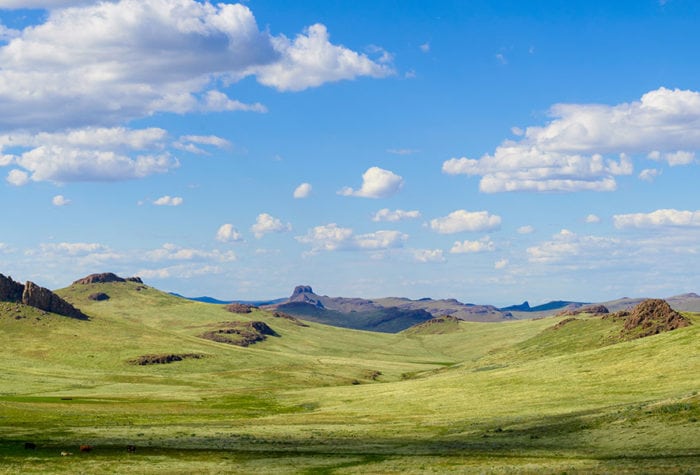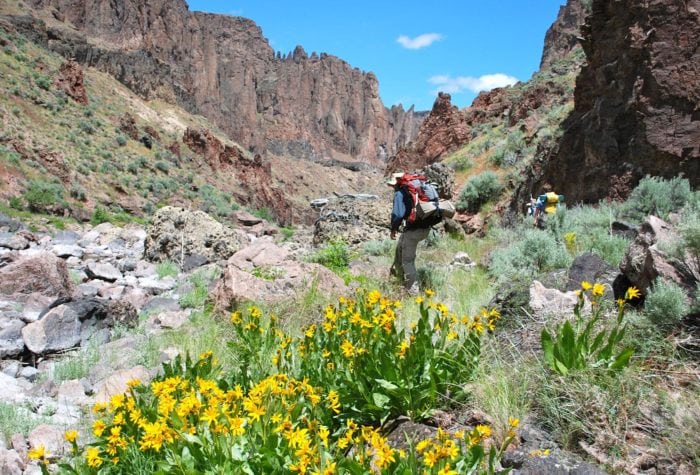Owyhee Canyonlands Fence Pull
Greg Burke Website
Organizer: Beth Macinko
Start Date: 5/18/2019
End Date: 5/21/2019
Region: Owyhee Canyonlands
Difficulty Rating: 3 out of 5
Maximum Group Size: 15 participants
About the place
Located in the far southeast corner of the state, Oregon’s Owyhee Canyonlands is one of the most wild places in the entire country. Here, natural conditions prevail and much of the area looks today as it has for generations, if not millennia. In the Owyhee, the opportunity to unplug and recharge is unparalleled. A long cherished destination for rafting, hunting, and fishing and a well-known wildlife mecca, the Owyhee Canyonlands deserve the strongest possible conservation protections.
Oregon Natural Desert Association leads a group of local, regional and national groups that recognize the conservation, recreation and economic values of the area. ONDA’s goal is to protect more than two million acres of public land in Oregon’s Owyhee Canyonlands. With strong protections in place, ONDA envisions an Owyhee where plant and animal communities flourish, wide-open spaces abound, and local communities thrive. Protecting the most special places within the Owyhee Canyonlands would safeguard its rich ancient history, healthy wildlife habitat, fascinating geology, and ample recreational opportunities.
About the stewardship work
Obsolete fences present barriers to wildlife movement and fragment landscapes. ONDA has worked for decades to help remove obsolete fences from Oregon’s high desert.
This project will involve the removal of temporary exclosure fences that are no longer needed. The fences were built to help reestablish sagebrush, planted after a recent fire, without pressure from grazing animals. Now that the sagebrush is robust enough to withstand browsing, it’s time to open this habitat up to sage-grouse.
Taking apart fences is scratchy, hot, dusty work… and incredibly satisfying. The work involves using hand tools to remove clips holding wire to posts, rolling up wire, and using a hand-operated post-puller to remove the metal fence posts. There is ample opportunity to choose specific tasks that match your fitness level and interest and to switch tasks throughout the day. We take frequent breaks and encourage folks to work at a sustainable pace. No experience is necessary; we can teach all you need to know.
Trip timeline
- Monday, May 18, 5 p.m: We will meet at the Riverside Campground and move into camp.
- Tuesday, May 19: We will leave camp around 8 a.m. and shuttle to our worksite. At the project site we will conduct a brief training and safety talk before a full day of pulling fence. Plan to arrive back in camp around 4 p.m.
- Wednesday, May 20: Similar to the day before, we will leave camp at 8 a.m. and head to our work site for another day of fence removal.
- Thursday, May 21: After a morning breakfast we will pack up and head back home. For those interested in spending more time in the area, we can organize group side trips and hikes.
Camp
We will be camping in the Riverside Campground, a primitive site along the Malheur River that has drive-in access. Further details will be provided to participants in the logistics email sent out three weeks prior to the trip departure date.
Difficulty
Some heavy lifting, car camping, and tasks associated with barbed wire fence removal. Volunteers will be able to choose tasks that fit their ability level and there will be plenty of opportunities for pacing and sharing of work tasks during the day.
Participant responsibility
Participants are responsible for their own food and food preparation, day pack and camping gear as well as transportation. Sturdy off-trail ankle-high boots are recommended for this trip.
Gear provided
ONDA will provide tools for the work, leadership and a number of group camp items to make things more comfortable such as a few chairs, a cook table, and sun/rain tarp. ONDA and the BLM will provide transportation to the work site from the BLM’s office in Lakeview.
Registration
An ONDA registration application and medical form are required for this trip. Check the box next to each trip you would like to attend. You only need to fill this form out once per year.
What happens next?
You will receive a confirmation email within 10 working days of submitting your form. The confirmation email will provide information regarding which trips you are on the “participant list” for, and which trips are full, and therefore you have been placed on the “waitlist.”
Six weeks before the start of the trip, the trip leader will send out an RSVP to make sure everyone is still able to participate. Based on RSVPs, open spaces will be backfilled with people from the waitlist.
Three weeks before the trip start date, registered and confirmed participants will receive driving instructions, maps, carpooling options, and additional information in an email sent by the trip leader
If you have any questions in the meantime, please don’t hesitate to contact the trip leader.
Your Trip Leader
This trip will be led by ONDA's Stewardship Coordinator Beth Macinko. For questions about the trip call (541) 330-2638 ext. 312 or email bmacinko@onda.org.
Meet BethRestoring Lands and Waters
Oregon Natural Desert Association sustains and enhances the health of Oregon’s high desert through stewardship and restoration. ONDA takes a holistic approach to conservation in Oregon’s high desert, pairing on-the-ground […]
Read More

